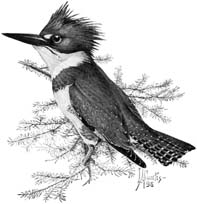|
Kingfishers |

Belted Kingfisher
(Ceryle alcyon)
|
|
Scientific classification |
| Kingdom: |
Animalia
|
| Phylum: |
Chordata
|
| Class: |
Aves
|
| Order: |
Coraciiformes
|
| Suborder: |
Alcedines
|
|
| Families |
Alcedinidae
Halcyonidae
Cerylidae |
Kingfishers are
birds of the three families Alcedinidae (river
kingfishers), Halcyonidae (tree kingfishers), and Cerylidae
(water kingfishers). There are about 90 species of kingfisher.
All have large heads, long, sharp, pointed bills, short
legs, and stubby tails. They are found throughout the world.
The taxonomy of the three families is complex and rather
controversial. Although commonly assigned to the
order
Coraciiformes, from this level down confusion sets in.
The kingfishers were traditionally treated as one family,
Alcedinidae with three subfamilies, but following the
1990s revolution in bird taxonomy, the three former
subfamilies are now usually elevated to familial level; a
move supported by chromosome and DNA-DNA hybridisation
studies, but challenged on the grounds that all three groups
are monophyletic with respect to the other Coraciiformes; which leads to them being grouped as the
suborder Alcedines.
The tree kingfishers have been previously given the
familial name Dacelonidae but Halcyonidae has
priority. This group derives from a very ancient divergence
from the ancestral stock.
Kingfishers live in both woodland and wetland habitats.
The Laughing
Kookaburra, at 45 cm the world's largest kingfisher, is a
woodland bird, while the European Kingfisher Alcedo atthis is always found
near fresh water.
Kingfishers that live near water hunt small
fish by diving. They also eat crayfish, frogs, and
insects. Wood kingfishers eat
reptiles. Kingfishers of all three families beat their
prey to death, either by whipping it against a tree or by
dropping it on a stone.
They are able to see well both in air and under water. To
do this, their eyes have evolved an egg-shaped
lens able to focus in the two different environments.
The
Old World tropics and Australasia are the core area for this
group. Europe and North America north of Mexico are very
poorly represented with only one common kingfisher (European
and Belted Kingfishers respectively), and a couple of
uncommon or very local species each: (Ringed Kingfisher and
Green Kingfisher in south Texas, Pied Kingfisher and
White-breasted Kingfisher in SE Europe).
Even tropical South America has only five species plus
wintering Belted Kingfisher. In comparison, the tiny African
country of The Gambia has eight resident species in its 120 by 20
mile area.
The six species occurring in the Americas are four
closely related green kingfishers in the genus Chloroceryle
and two large crested kingfishers in the genus Megaceryle,
suggesting that the sparse representation in the western
hemisphere evolved from just one or two original colonising
species.
External links




